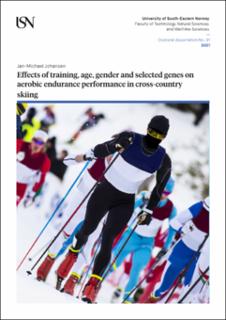| dc.contributor.author | Johansen, Jan-Michael | |
| dc.date.accessioned | 2021-11-02T09:39:31Z | |
| dc.date.available | 2021-11-02T09:39:31Z | |
| dc.date.issued | 2021-04-22 | |
| dc.identifier.isbn | 978-82-7206-594-1 | |
| dc.identifier.issn | 2535-5252 | |
| dc.identifier.uri | https://hdl.handle.net/11250/2827210 | |
| dc.description.abstract | The main objective of this thesis was to investigate the effects of training, age, gender and selected genetic variants on aerobic endurance performance and training adaptations in well-trained cross-country skiers. The skiers recruited for the different studies were either exclusively characterized as national-level cross-country skiers (Study I and III) or recreational- to national-level cross-country skiers (Study II). In all studies, both male and female, young and adult skiers were recruited.
The relationships between performance results from a roller-skiing double poling time trial (TTDP) and a large set of aerobic endurance variables, muscular strength variables and technique-specific characteristics in double poling (DP) were studied in study I. These associations were investigated in young male and female cross-country skiers (n = 28). Both dependent and independent of gender, strong correlations were observed between maximal strength in pull-down and TTDP (r = - 0.83, p < 0.01 and r = - 0.50, p < 0.02, respectively). Among the aerobic variables, the same were observed for maximal aerobic speed (MAS, r = - 0.80, p < 0.01) and peak oxygen uptake in DP (DP-VO2peak, r = - 0.80, p < 0.01). Stronger skiers were also associated with higher peak forces (r = 0.78, p < 0.01), lower cycle rate (r = - 0.71, p < 0.01) and shorter contact time (r = - 0.48, p < 0.02) during double poling.
In study II, effects of a 6 weeks DP-specific high-intensity aerobic training (HIT) intervention was investigated. This intervention was performed without increasing total training volume or HIT volume. Seven recreational-level skiers were recruited for the intervention group, while seven national-level skiers served as controls. All skiers were tested in a 3-km TTDP on a treadmill, maximal oxygen uptake in running (RUN-VO2max), DP-VO2peak and oxygen cost of DP (CDP). The intervention group trained DP-specific HIT 3 times per week during the intervention. Significant improvements were observed in MAS (+16.5%, p < 0.01), DP-VO2peak (+7.1%, p < 0.05), CDP (-9.2%, p < 0.05), fractional utilization of RUN-VO2max while DP (+7.3%, p < 0.05) and TTDP (+19.5%, p < 0.01). The control group did not display any improvements during the intervention.
In study III, the physiological adaptations to six months traditional cross-country ski training were examined. In addition, effects of age, gender and selected genetic variants at baseline and on training adaptations were investigated. All included skiers (n = 29) were tested in a large set of physiological and performance variables, and all training performed was registered based on heart rate measures. Even though there were some variations in training characteristics, only minor changes were performed in training by the participants. Thus, no significant training adaptations were displayed over 6 months, with no differences across gender and age. At baseline, gender and age did reveal significant effects on TTDP (p < 0.01), MAS, (p < 0.01), DP-VO2peak (p < 0.01) and maximal strength variables (p < 0.01). For the genetic variants, only minor associations were observed at baseline.
Taken together, pooled analyses from study I and III points to the major importance of MAS and maximal strength in upper-body muscles for cross-country skiing performance. In addition, these two variables seemed as important underlying physiological factors for several other performance-related variables.
No physiological adaptations were observed in skiers that did no to minor changes in training characteristics over shorter (6 weeks in study II) or longer (6 months in study III) training periods. However, large improvements were observed in skiers specifically altering their HIT training over short training periods (study II). Gender and age was found to have large effect on initial performance- and physiological capacity, while no effects were evident on training adaptations. For selected genetic variants, minor effects were observed in baseline values. | en_US |
| dc.language.iso | eng | en_US |
| dc.publisher | University of South-Eastern Norway | en_US |
| dc.relation.ispartofseries | Doctoral dissertations at the University of South-Eastern Norway;91 | |
| dc.relation.haspart | Article 1: Sunde, A., Johansen, J.-M., Gjøra, M., Paulsen, G., Bråten, M., Helgerud, J. & Støren, Ø.: Stronger is better: the impact of upper body strength in double poling performance. Frontiers in Physiology 10 (2019), 1091. http://dx.doi.org/10.3389/fphys.2019.01091 | en_US |
| dc.relation.haspart | Article 2: Johansen, J.-M., Eriksen, S., Sunde, A., Slettemeås, Ø.B., Helgerud, J. & Støren Ø.: Improving utilization of maximal oxygen uptake and work economy in recreational cross-country skiers with high-intensity double-poling intervals. International Journal of Sports Physiology and Performance 16(1), (2020), 1-8. http://dx.doi.org/10.1123/ijspp.2019-0689. Reprinted by permission | en_US |
| dc.relation.haspart | Article 3: Johansen, J.-M., Goleva-Fjellet, S., Sunde, A., Gjerløw, L.E., Skeimo, L.A., Freberg, B.I., Sæbø, M., Helgerud, J. & Støren, Ø.: No change – no gain; The effect of age, sex, selected genes and training on physiological and performance adaptations in cross-country skiing. Frontiers in Physiology 11 (2020), 1-20. https://doi.org/10.3389/fphys.2020.581339 | en_US |
| dc.rights.uri | http://creativecommons.org/licenses/by-nc-sa/4.0/deed.no | |
| dc.title | Effects of training, age, gender and selected genes on aerobic endurance performance in cross-country skiing | en_US |
| dc.type | Doctoral thesis | en_US |
| dc.description.version | publishedVersion | en_US |
| dc.rights.holder | © The Author, except otherwise stated | en_US |
| dc.subject.nsi | VDP::Medisinske Fag: 700::Idrettsmedisinske fag: 850::Treningslære: 851 | en_US |

